The team at Point to Point Education have found your next holiday spot!
For our teachers who love to travel and are looking for somewhere to explore during the UK school holidays, we have just spent some time in Croatia and we think you’ll love it!
We arrived in Split and checked into our Airbnb in the old town. Split Old Town is the historical and cultural centre in Croatia. It is the second-largest city of Croatia after the capital Zagreb, the largest city in Dalmatia and the largest city on the Croatian coast.
Once checked in, we wandered the old cobble stoned streets and through the village. You can easily spend all day doing this. Every building is beautiful and each corner you turn you can’t believe what you’re seeing. There are lovely little shops and hidden ally ways throughout and loads of very stylish cafés and restaurants.
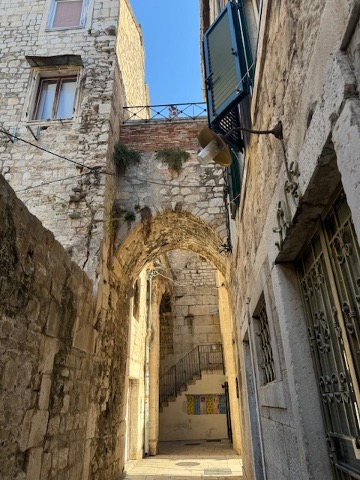
In the middle of the village, you find the palace. If you want a good photo, get there early before all the crowds.
Diocletian’s Palace was built at the end of the third century AD as a residence for the Roman emperor Diocletian and today forms about half of the old town of Split, Croatia.
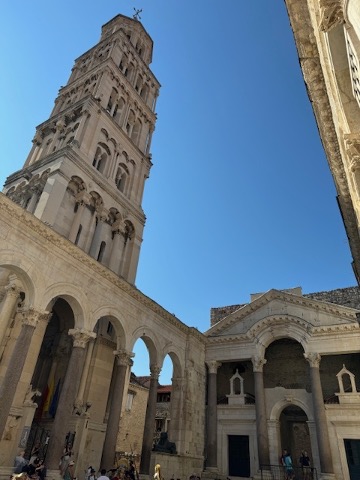
We then went for a little hike up Marjan. Marjan is a hill on the peninsula of the city of Split. Marjan is 178 m tall and offers a view of the entire city. You can get some amazing photos up here and there is also a nice little café to grab a drink and cool down. There are loads of different trails and a circuit, or you can just go straight to the lookout.
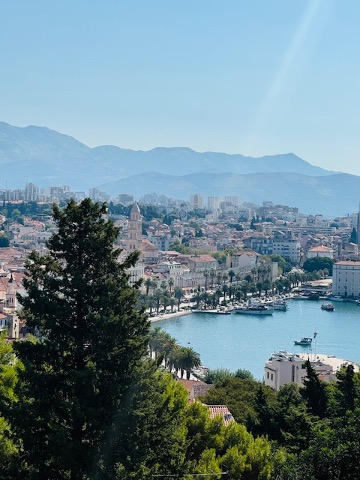
We had a rental car, so we then took a visit to Trogir. The ancient town of Tragurion was founded in the 3rd century BC as a trading settlement by Greek colonists. It was about a 25 min drive from Split.
It’s a tiny medieval town which you just wander through. It has lots of nice little eateries and gift shops. Markets line the jetty where you can find little gifts and souvenirs.
It also has a nice esplanade you can walk along, with castle ruins which you can go in.
It’s a nice little trip for a few hours if you want to get out of Split.

After a lovely few days in Split we then took the car ferry over to Brač. It’s a quick 40 min ferry ride, but it is a bit scary driving your car on! Get to the terminal early as it’s very busy!
Brač is a Croatian island in the Adriatic Sea. It’s best known for the white-pebble beach, Zlatni Rat (Golden Cape), a favored windsurfing site outside the resort town of Bol. Supetar, the island’s main town, offers a horseshoe-shaped beach and ferries to and from Split
We stayed in a beautiful little village called Postira and after all our exploring decided this was our favourite. We had a beautiful little beach to swim at which wasn’t crowed, a handful of great restaurants and we happened to be there on fisherman’s night, so got to experience a local celebration.
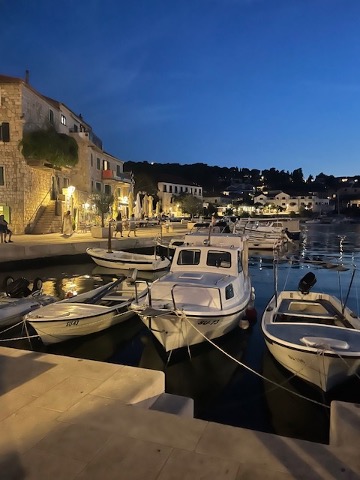
We were here for 3 days, so we drove around the island visiting all the little towns. Really, all you do here is walk the old villages, swim and eat – it’s all about the seafood!
Our next favourite village was Bol. This was another nice little town with a lot going on. Lots of action on the water, nice walks and little shops and markets. This is where the Golden Horn Beach is that everyone loves.

We also quite liked Milna, another seaside village. Not a lot to do, but it’s very picturesque and it’s nice to just wander with a coffee and take photos and get a feel for it all. This island is very relaxing and if you want a place to just chill out for a bit and enjoy some amazing sites, this is a must do.
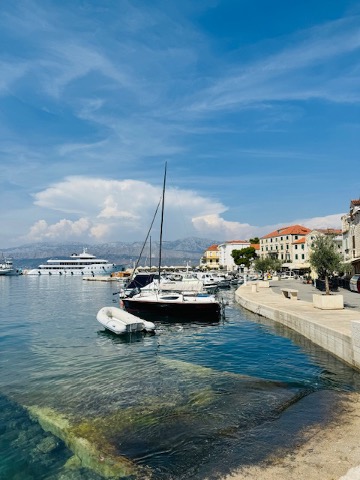
The buildings in Brač are all made of the stone that was used to build the White House. Brač stone is one of the most famous stones used in construction and architecture in Croatia. Monuments such as Diocletian’s Palace in Split, and many churches and buildings throughout Dalmatia were created from this stone. There are lots of stone carvings and ornaments to buy at the market if you like it.
Another great thing to do here is to visit the Stonemason School in Pučišća’ you can find out more here https://klesarskaskola.hr/
We then moved on from Brač and drove to Korčula. We took the ferry back from Brač to Split and drove 3 or so hours and arrived in a very cute place in Korčula. It’s not as well known as the bigger places, but it’s very rustic and quiet!
We mostly spent our 3 days here just exploring the island. We walked through the old village which we loved! It’s got lovely little cafes, shops and beautiful buildings and landmarks.
Korčula Old Town is the island’s treasured highlight and a UNESCO World Heritage Site candidate. Its stone architecture and historic ambiance reflect almost four centuries of Venetian rule, with towered gates, lion statues, magnificent palazzos, and elaborate stonework peppering the charming streets.
We then took a ferry island hopping and visited Badija and Stupe https://www.korculaboating.com/water-taxi/water-taxi-hop-on-hop-off/
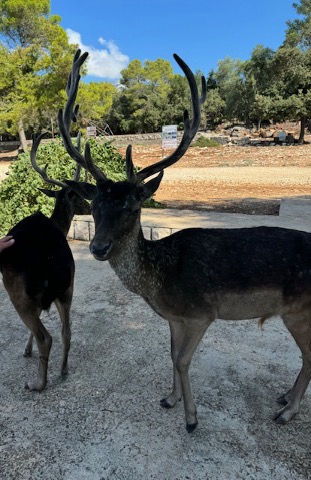
It was €20 for a 3-island hop-on-hop-off ferry, and you could spend as much time as you wanted at each place. The water was the clearest I have ever seen and so refreshing. You’ll also spot a few reindeer. If you are going for the day, buy some food from the mainland and take it with you.

After a few days in Kokula we drove through to Debrovnik. This was about a 4-hour drive which included passing through Bosnia. There are two border crossings here so have your passports handy.
We spent three days here, with a lot to do and see!
We did a walking tour on the first day to get an idea of where we were staying. I recommend doing this early on at each place you visit so you know the significance of what you’re seeing.
Dubrovnik is a city in southern Croatia fronting the Adriatic Sea. It’s known for its distinctive Old Town, encircled with massive stone walls completed in the 16th century
When you come here it involves lots of walking, so wear good shoes! They also prefer trading in cash to save on tax, so have some cash on you always.
We were here in late August and it was so hot, but there are lots of beautiful swimming spots and beach clubs for you to visit.
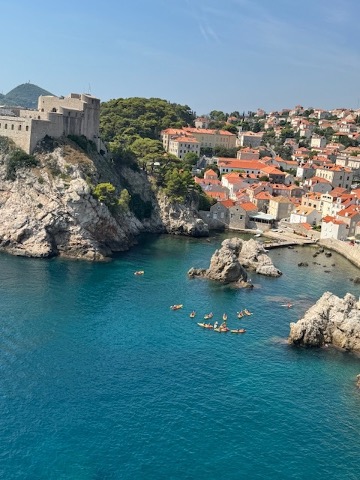
I really liked walking the outer wall. It took about 30 minutes and gave you views of the old town from all angles. The Walls of Dubrovnik have a rich history. Records state that the initial walls were built around the 9th century. The Walls of Dubrovnik are a significant landmark and efficient defense mechanism against the foreign attacks for the city.
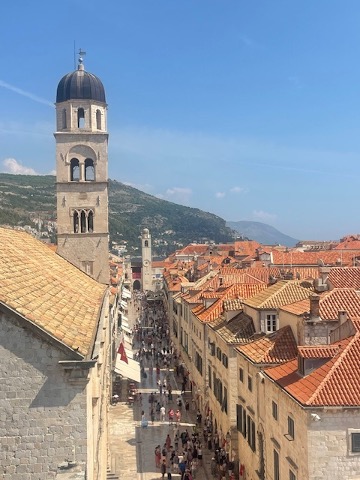
I recommend getting a day pass to walk the walls, visit the place and all the museums as this will cost £35 but covers everything.
On our last day here, we took the ferry across to Lopud Island. This was just a 15-minute trip from the old town. If you buy your ticket the day before you will save yourself €5.
We loved it here. It was nice to get away from all the people in the old town and have some space. Here you can wander around the gardens, see where parts of Game of Thrones was filmed and enjoy some beautiful swimming spots. There is a Salt Lake https://tourist.hr/place/the-dead-sea There are also a few cafes here in nice shady spots. We rented a sunlounger for £10 so we could make the most of the day and find a comfortable spot to relax for a bit.
For all our teachers who are looking for a place to visit in the next UK school holidays, I would highly recommend Croatia. You probably need at least 10 days, and I would say to pick 3 different islands so you can get feel for the country. You won’t be disappointed, and you’ll be nice and relaxed when you head back to school!

The Impact of Finder’s Fees on Teacher Recruitment: Are They Worth the Cost?
Recruiting and retaining top teaching talent is one of the biggest challenges facing schools today. With an ongoing teacher shortage and increasing financial pressures, many schools turn to supply agencies…
Read More
Teaching in Melbourne: Your Ultimate Guide to a Rewarding Career
Why Teach in Melbourne, Australia? Melbourne is consistently ranked as one of the world’s most liveable cities. Known for its vibrant culture, thriving arts scene, and renowned coffee culture, it…
Read More
